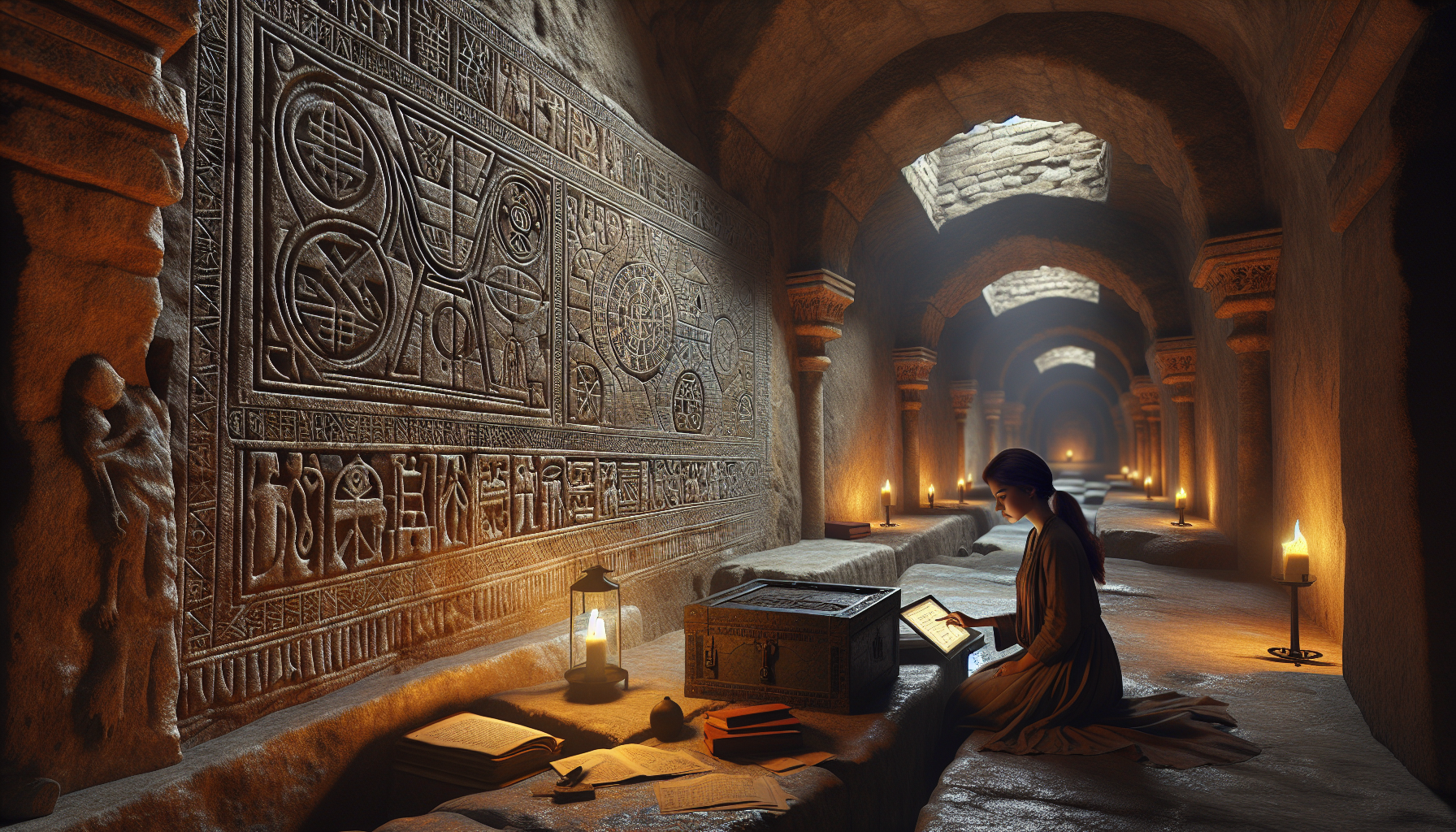In the annals of history, few organizations have captivated the imagination and fueled as many myths and legends as the Knights Templar. Established in the early 12th century, this medieval Christian military order swiftly became one of the most powerful entities in the world. Yet, it was not only their martial prowess and extensive wealth that made them legendary; it was also their enigmatic use of symbolic cryptography that has intrigued scholars, historians, and conspiracy theorists alike for centuries. The cryptic legacy of the Templars, interwoven with codes and symbols, continues to echo through time, challenging our understanding of their true influence and the secrets they left behind. 🔍
Symbolic cryptography was more than a mere method of concealing information for the Templars; it was an intricate tapestry of signs and symbols, each woven with layers of meaning, both sacred and secular. From the iconic red cross emblazoned on their tunics to the geometric patterns etched into their chapels, the Templars employed a complex language of symbols that communicated messages to those who were initiated into their mysteries. This article delves into the heart of this cryptic legacy, exploring the profound influence these symbols wielded—not just within the order itself, but across medieval society and beyond.
One of the fascinating aspects of Templar symbolic cryptography is how it intertwines with various cultural, religious, and philosophical traditions. The Templars were known to have absorbed knowledge from diverse cultures, including the Islamic world during the Crusades, which enriched their own symbolic lexicon. By examining the cross-cultural exchanges and syncretic practices of the Templars, we can begin to decode the cryptic language they employed. This exploration reveals a tapestry of symbols that reflect a unique synthesis of Christian iconography and esoteric knowledge, offering insights into how the Templars may have viewed their spiritual mission and their place in the world.
In this article, we will journey through the shadowy corridors of history, from the formation of the Templar order to their dramatic downfall and enduring legacy. We will uncover the symbols that defined their cryptography, examining key examples such as the enigmatic carvings found in Templar chapels and the mysterious symbols embedded in their seals and architecture. By understanding the historical context and the intended meanings behind these symbols, we can better appreciate the sophisticated communication methods the Templars used to protect their secrets and convey their messages.
Ultimately, the influence of Templar symbolic cryptography extends far beyond the Middle Ages. Its legacy can be traced in the secret societies that emerged in the centuries following the Templars’ dissolution, and in modern popular culture, where the Templars continue to inspire a sense of mystery and intrigue. This article aims to illuminate the Templars’ cryptic legacy, inviting readers to embark on a quest of discovery that reveals how these medieval knights, through their mastery of symbolic cryptography, have left an indelible mark on history that continues to fascinate and inspire to this day. 🏰
The Enigma of the Templars’ Symbolic Cryptography
The Knights Templar, a medieval Christian military order, are often shrouded in mystery and intrigue. Their influence has permeated through various facets of history, most notably through their use of symbolic cryptography. Symbolic cryptography, the practice of encoding messages or ideas using symbols, was a key aspect of Templar operations. This clandestine method of communication not only safeguarded their secrets but also contributed significantly to the enigmatic aura that surrounds the order today. By examining the intricate symbolism used by the Templars, we can begin to decode the profound influence this cryptic language had on history.
One of the most compelling aspects of Templar cryptography is its complexity and depth. The Templars employed a range of symbols, each carrying multiple layers of meaning. These symbols were often drawn from religious iconography, alchemical symbols, and even esoteric traditions. For example, the Templar cross, a distinct symbol of the order, held both spiritual and operational significance. Its symmetrical design not only represented their religious devotion but also served as a cipher for conveying strategic information during the Crusades. This dual-purpose approach is a hallmark of Templar cryptography, illustrating their ability to weave spiritual and practical elements into a cohesive whole.
Moreover, the Templars’ use of symbolic cryptography extended beyond mere communication. It was a tool for reinforcing their ideological framework and ensuring the continuity of their legacy. The symbols used by the Templars were carefully chosen to resonate with their members, creating a shared language that transcended spoken word. This was particularly crucial during times of persecution when open communication could lead to the order’s downfall. The cryptic nature of their symbols provided a protective veil, allowing the Templars to operate in secrecy and maintain their influence even in the face of adversity.
The Multifaceted Role of Templar Symbols
Templar symbols were more than mere ciphers; they were multifaceted tools that served various roles within the order. Firstly, they functioned as a means of communication, encoding messages that could be understood only by those initiated into the Templar tradition. This was vital during the Crusades, where secure communication was essential to the success of military campaigns. The Templars developed a unique symbolic language that allowed them to relay information about troop movements, strategic plans, and other sensitive data without arousing suspicion from their adversaries.
In addition to their communicative function, Templar symbols played a significant role in the order’s spiritual practices. The symbols were often imbued with religious significance, serving as reminders of the Templars’ divine mission. This spiritual dimension added another layer of meaning to the symbols, reinforcing the order’s commitment to their faith. For instance, the symbol of the lamb, often depicted alongside the Templar cross, symbolized Christ’s sacrifice and served as a powerful reminder of the Templars’ duty to protect the Christian faith. This spiritual symbolism was a key aspect of the Templar identity, fostering a sense of unity and purpose among its members.
Furthermore, Templar symbols were instrumental in building and maintaining the order’s identity. The use of distinctive symbols helped create a sense of belonging among Templar members, strengthening the bonds of brotherhood within the order. These symbols also served as a form of identification, allowing members to recognize each other and establish trust in uncertain times. This sense of identity was crucial for the Templars, particularly during periods of persecution when maintaining cohesion and loyalty was paramount to their survival.
Decoding the Historical Impact of Templar Cryptography
Understanding the historical impact of Templar cryptography requires a closer examination of how these symbols influenced broader cultural and historical developments. The Templars’ use of symbolic cryptography had a profound effect on the development of cryptographic practices in Europe. Their methods laid the groundwork for future advancements in cryptography, influencing both the practice and theory of secure communication. The Templars’ innovative use of symbols as a means of encoding information paved the way for the development of more sophisticated cryptographic techniques in the centuries that followed.
The legacy of Templar cryptography can also be seen in the cultural and artistic realms. The Templars’ symbols have inspired countless works of art, literature, and architecture, leaving an indelible mark on European cultural heritage. The symbolism employed by the Templars has been interpreted and reinterpreted over the centuries, becoming a source of fascination for historians, artists, and scholars alike. This enduring interest in Templar symbolism underscores its lasting impact on Western culture and highlights the order’s significant role in shaping the historical narrative.
Moreover, the influence of Templar cryptography extends to contemporary discussions on secrecy and conspiracy. The enigmatic nature of the Templars’ symbols has fueled speculation and intrigue, leading to various theories about hidden meanings and secret knowledge. This fascination with the Templars’ cryptic legacy continues to captivate the public imagination, reflecting the enduring appeal of their mysterious and secretive nature.
Comparative Analysis of Templar Symbols and Modern Cryptography
To fully appreciate the significance of Templar cryptography, it is useful to compare it with modern cryptographic practices. Both systems share a common goal: the secure transmission of information. However, the methods and tools employed by the Templars and modern cryptographers differ significantly. While the Templars relied on symbolic language and esoteric meanings, modern cryptography utilizes mathematical algorithms and digital encryption techniques.
Despite these differences, there are notable parallels between Templar cryptography and modern practices. Both systems prioritize secrecy and require a certain level of initiation or understanding to decode the information. In both cases, the cryptographic methods are designed to protect sensitive data from unauthorized access, ensuring that only those with the necessary knowledge or tools can decipher the messages. This commonality underscores the timeless nature of the need for secure communication and highlights the Templars’ contributions to the evolution of cryptographic practices.
Furthermore, the symbolic nature of Templar cryptography offers insights into the cultural and psychological aspects of cryptography. The use of symbols to convey hidden meanings reflects a deep understanding of human cognition and the power of symbols to communicate complex ideas. This aspect of Templar cryptography is particularly relevant in today’s digital age, where visual symbols and icons play a crucial role in the way we process and interpret information.
Exploring Templar Cryptography through Modern Media
In the digital age, exploring the legacy of Templar cryptography has been made easier through various forms of media. Documentaries, books, and online resources offer in-depth analyses of the Templars’ symbolic language, providing valuable insights into their cryptic world. For those interested in delving deeper into this fascinating subject, there are numerous resources available that explore the Templars’ use of symbols and their historical significance.
One particularly engaging way to explore Templar cryptography is through video content. Platforms like YouTube host a wealth of videos that delve into the mysteries of the Templars, offering visual and auditory insights that complement written accounts. For example, the video “The Templars: Secret Symbols and Hidden Codes” from the History Channel provides an engaging overview of the symbols used by the Templars and their cryptographic significance. Watching such videos can enhance your understanding of Templar cryptography and offer a fresh perspective on this historical enigma. Watch the video here 📺
Additionally, interactive online platforms and forums allow enthusiasts to share insights and discuss theories related to Templar symbols. These communities provide a space for collaborative exploration and offer a platform for sharing new interpretations and discoveries. Engaging with these resources not only enriches your understanding of Templar cryptography but also connects you with a broader community of individuals passionate about uncovering the secrets of the past.
Call to Action: Dive Deeper into the World of the Templars
If you’re intrigued by the mysteries of Templar cryptography and eager to learn more, consider exploring the following resources:
- Read books on the history of the Knights Templar and their cryptographic practices.
- Watch documentaries and video content that delve into the Templars’ symbolic language.
- Join online forums and communities dedicated to exploring historical cryptography and the Templars.
- Visit historical sites and museums that feature exhibits on the Templars and their legacy.
By immersing yourself in these resources, you can gain a deeper understanding of the Templars’ cryptic legacy and appreciate the enduring influence of their symbolic language on history.

Conclusion
In conclusion, “Unveiling the Templars’ Cryptic Legacy: Decoding the Influence of Symbolic Cryptography in History” has taken us on an enlightening journey through time, exploring the complex and intriguing world of the Knights Templar and their enduring legacy. Through this exploration, we have uncovered the profound influence of symbolic cryptography in shaping historical narratives and the development of secret societies. This study has highlighted several key aspects that underscore the Templars’ significant role in history and the lasting impact of their cryptic symbols.
Firstly, we delved into the historical context of the Templars, understanding their rise during the Crusades and their subsequent fall, which left an indelible mark on history. The Templars were not only warriors but also pioneers in financial systems, influencing modern banking. Their adeptness at maintaining secrecy and protecting their knowledge through cryptographic means was instrumental in their success and mystique.
Furthermore, we examined the intricate symbols associated with the Templars, such as the cross, the lamb, and the grail, each imbued with deep meaning and utilized as a form of communication among members. These symbols were not merely decorative; they served as a sophisticated language that transcended spoken word, ensuring the continuity of their traditions and beliefs. Through symbolic cryptography, the Templars were able to convey complex messages securely, a practice that has fascinated historians and cryptographers alike.
Another critical point addressed was the Templars’ influence on subsequent secret societies, such as the Freemasons and the Rosicrucians. The Templars’ methods of cryptography and their symbolic language were adopted and adapted by these groups, further perpetuating their legacy. This transmission of knowledge underscores the timeless nature of cryptographic practices and their adaptability across different contexts and eras.
The exploration also highlighted the impact of symbolic cryptography on art and architecture, as Templar symbols have been found in various historical structures, influencing the design and meaning of numerous edifices throughout Europe. These symbols continue to capture the imagination of historians, archaeologists, and enthusiasts, offering clues to a past shrouded in mystery and intrigue.
Additionally, we discussed the technological advancements in cryptography, tracing their roots back to these early practices. The Templars’ innovative use of symbols laid the groundwork for modern cryptographic techniques, showcasing the enduring relevance of their methods in today’s digital age. As we continue to grapple with issues of privacy and security, understanding the origins of these practices provides valuable insights into their evolution and significance.
The importance of studying the Templars’ cryptic legacy cannot be overstated. In an era where information is both a powerful tool and a potential threat, learning from historical examples of symbolic cryptography can inspire new approaches to secure communication. The Templars’ legacy serves as a reminder of the ingenuity and adaptability of human societies in preserving and protecting knowledge.
As we conclude this exploration, it is essential to recognize the continued relevance of the Templars’ cryptic legacy in contemporary discourse. The study of their symbols and cryptographic practices offers valuable lessons in resilience, innovation, and the preservation of knowledge. It also invites us to reflect on the power of symbols and the ways in which they shape our understanding of the world.
We encourage readers to delve deeper into this fascinating subject, exploring the rich tapestry of history woven by the Templars and their cryptographic legacy. Whether you are a historian, a cryptographer, or simply someone with a passion for the mysterious and the unknown, there is much to learn and discover.
Feel free to share your thoughts and insights in the comments section below. Engaging in discussions and sharing knowledge can further enrich our understanding of this intriguing topic. We also invite you to share this article with others who may be interested in the enigmatic world of the Templars and the enduring impact of symbolic cryptography.
By fostering a community of curious minds, we can continue to explore and uncover the mysteries of the past, gaining new perspectives and insights that inform our present and future endeavors. Let’s embrace the legacy of the Templars as a source of inspiration, reminding us of the power of symbols and the importance of safeguarding knowledge for generations to come. 🌟
For further reading, consider exploring these resources:
1. “The Knights Templar: The History and Myths of the Legendary Military Order” by Sean Martin.
2. “The Templars: The Rise and Spectacular Fall of God’s Holy Warriors” by Dan Jones.
3. Online resources on cryptography from trusted academic institutions such as MIT’s Cryptography and Information Security Group and Stanford University’s Applied Cryptography Group.
Thank you for joining us on this captivating journey into the cryptic legacy of the Templars. May the symbols and stories of the past continue to inspire and guide us in our quest for knowledge and understanding.
Toni Santos is a visual cryptographer and artisan, weaving hidden meaning into every line, curve, and composition. His creations delve into the mysterious world of secret codes, symbolic alphabets, and invented languages, transforming visual art into a rich tapestry of communication beyond words.
Guided by a lifelong fascination with hidden knowledge and the power of symbols, Toni explores how meaning can be embedded, concealed, and rediscovered. From constructed glyphs to encoded illustrations, each piece he creates serves as a portal to a deeper layer of understanding — one that invites curiosity, interpretation, and wonder. His work bridges the intuitive with the intellectual, the mystical with the methodical.
With roots in handcrafted artistry and a background in visual semiotics, Toni fuses form and function to create works that whisper rather than shout. These are not just images — they are visual riddles, poetic encryptions, and artifacts of a language yet to be spoken.
As the creative mind behind Vizovex, Toni offers a space where art meets encryption, and viewers are invited to decode, reflect, and engage. Through symbolic design, visual lexicons, and explorations into constructed languages, he builds a universe where meaning is layered, intentional, and always slightly out of reach — waiting to be discovered.
His work is a tribute to:
The unseen languages that shape our perception
The art of hidden messages and symbolic systems
The thrill of decoding and the beauty of mystery
Whether you’re a language lover, a codebreaker at heart, or someone drawn to the enigmatic, Toni invites you to explore a world where expression transcends convention — one glyph, one message, one mystery at a time.





